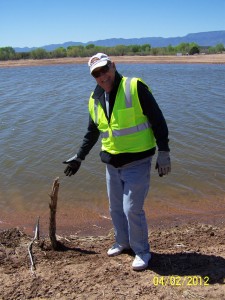Sedona AZ (August 28, 2013) – The waste water plant is an Enterprise Fund, which means it is supposed to charge what it costs to operate. This has not been the case for many years. How did we get to this point and what is being done to address the issue?
Around 1984, a study was conducted by what is now the Arizona Department of Environmental Quality (ADEQ) regarding individual septic systems in the Sedona area. According to that study, over half of the septic systems in the Sedona area were non-compliant with applicable regulations. Also in 1984, an Environmental Assessment was conducted with regard to effluent disposal plans proposed by the Sedona Sanitary District, which had been formed in 1982. The report concluded that “on-site septic systems using leach fields in shallow soils were a threat to the environment since nutrient rich septic tank effluent would flow on top the underlying rock down gradient to Oak Creek.” It appears that these findings prompted ADEQ to require improvement of the Sedona area wastewater system. In 1985, an unsuccessful attempt was made to incorporate the Sedona and Village of Oak Creek to manage this issue. It failed, but in 1987, incorporation of Sedona was approved. The Sedona Sanitary District was disbanded and the City took on management of the wastewater system.
The costs to comply with ADEQ requirement for improvements to both the treatment plant and collection system were in the tens of millions of dollars. The City could not self-finance these improvements and comply with the time constraints of the Consent decree. Bonds needed to be sold to obtain the financing required. The inducement for community support of the bonds was a promise made to the residents of Sedona. That promise was, “If you will support the bonds needed to build the underground sewer lines, pumping stations and the waste water plant, the city will use some of its sales tax revenue from tourists to subsidize the cost.” From 1996 to 2010, the individual sewer fee remained unchanged at $32.54. That fee was well under the true cost of providing the service, as evidenced by the fact that by 2010 the general fund subsidy to the Wastewater Enterprise was 46%. The general fund is basically funded by sales tax revenues.
A few years ago, the Sedona City Council began the process of reducing the waste water plant’s dependency on sales tax. This would allow the sales tax revenue going to the Wastewater Enterprise to be used for non-enterprise activities of the City. The percentage of sales taxes going to operate the waste water plant has been steadily dropping each year. It has dropped from 46% in 2009 to 35% planned for the 2014 budget cycle.
Individual sewer fees have been gradually increasing each year to shift the cost of operating the waste water plant to the users of the service. The City has taken several actions over the last few years to contain the system costs. By continuing to contain the system costs, the City will reduce the impact of reducing the general fund support of the system on users. The unsupported cost of operating the waste water plant for each single family has most recently been estimated to be around $80 per month. The plan for the 2014 budget cycle was to increase the individual sewer fees by 10 percent. This increase will not happen. The waste water reserve fund is strong enough to operate without the increase. It is unclear whether the budget cycle for 2015 will also provide for no additional sewer fee increases.
The city directs approximately four million dollars annually from sales taxes to subsidize the waste water plant. An additional six million dollars goes to servicing the principal and interest on the bond debt.
Instead of having one fixed sewer fee for residences, the city is studying the feasibility of tying the sewer fee to actual water use by residences and businesses to better reflect their impact on the wastewater system.
The corporate debt of Sedona is around 51 million dollars. This debt is mostly linked to the waste water plant bonds. If no additional debt is incurred, the city will be debt free by 2027.
The city has contracted with Edison Solar to install solar panels at the waste water plant to help offset the cost of operating the treatment plant. It is expected that these panels will be operational sometime this year at no cost to the city and that the city will save over one million dollars in electric charges over the next twenty years.







why are people concerned about sewer fees? the city w/o sewer? everyone should have sewer, nobody on septic. you’ve got to pay for quality of life or go live in a rv in the desert
There’s more waste than just sewage at the WWTP. The sewer is an experiment and a boondoggle. Claims that the City has been, and is, containing costs is BS. The City doesn’t give a damn.
Pollution from tourist businesses near Oak Creek begot the ADEQ Consent Decree and the WWTP. The City is socializing the enormous debt on the WW bonds plus other costs on the backs of residential ratepayers who: (1) had no part in polluting Oak Creek and (2) were/are not responsible for paying to run sewer lines out to the borders of new developments.
I used to bird the treatment plant with the local Audubon Society after moving to Sedona 12 years ago. There were approximately 5 ponds adjacent to Hwy 89A where the “new wetlands” location is. Just as our local streets and drainage history, these ponds were not maintained. Eventually plant-life overgrowth became a problem (planned?). Eventually cows were allowed to graze the area and woof down the vegetation. Next taxpayers got a prohibitively expensive “new wetlands”–with algae and not that many bird species and numbers–to replace a fine wetlands with diversity.
Hmmm. According to the City Engineer during the Council’s April 26, 2013 Budget Workshop: The cost for the design and construction to expand the wetlands is $1 million. $1.6 million is the cost for the current injection well, with the possibility of a second well. He doesn’t know if injection will work. There are wetlands’ capacity enhancements needed for 2 million gallons/day. We’re now at about 1.1 or 1.2 million. He doesn’t know how much water the plant can take.
BTW, now scheduled for next fiscal year at an estimated cost of $250,000: Feasibility Study of a Multi-Purpose Facility at the WWTP.
To Debra T.
May I suggest you ask the city council and staff why they are more concerned about buying land for parks, creek walks, feasibility study for multipurpose facility at the sewer plant, over and above giving out millions, yes millions of $$$ to each and every alleged “non-profit” standing in line at city hall for the taking? Unless city council and staff begin to display an earnest support for residents living within incorporated Sedona instead of their devotion to the Chamber of Commerce who continue to monopolize city hall only to drum up business for those who do not collect city taxes, why shouldn’t residents revolt to high sewer bills and increased taxes that have been created due to misdirected leadership?
Gotta agree with Marty. No need to have city own any more land they can’t afford to take care of. No more need to spin $ to the regional Chamber…so lets get back down to basic issues!
Couple other issues needing to be added to the discussion and ones I guess Debra T and Jean are not aware of: Appreciate Dan’s writings but he missed the mark.
First and foremost it was residents combined with business’s that caused the need for a better septic or central treatment system. But more importantly it was the folks who wanted incorporation and cried wolf on the reality of how supposedly bad septic systems were…..one place that comes to mind was uptown and buildings owned my Dr MacFarland…that he rented out and allowed raw sewage running down by the buildings he owned. (his wife – Anita MacFarland got the newest birdie ponds passed by council – can’t even figure out how she became charmed of birds as he wasn’t – he just ignored reality)
Residents along the creek were supposed to also be partof the problem. Residents off the creek were added to the issue…and then the mother’s and father’s of incorporation scared the hell out of everyone …and the rest is history.
Reality? Yes there was a Consent Decree. That is the only factual statement in all of the above posts and Dan’s article!
Yet none of you know that the Consent Decree only came about in 1994 or 1995 (well after incorporation) as a result of a major breach in the sewer system lines that sent the raw sewage spewing out of a manhole and down into Carroll Canyon.
Other reality is that an early Council passed a dedicated 2% Sales Tax hike dedicated to only Wastewater…and now our Council has figured out how to deviously steal money away from those revenues to accommodate their personal, political Santa Lists.
The next issue is almost the most flagrant: Our current Council has also figured out how to charge citizens who own vacant lots where an existing sewer line runs in front of that lot.
What am I talking about? Easy: they passed a law saying they will charge a fee for not hooking up!!!! it runs about $29/month. I’m serious – even as this just sounds crazy!
Question to all readers and Council and Staff: Have you ever heard of APS, Arizona Water Co, Oak Creek Water Co, Sudden Link, Unisource Gas, etc. – asking anyone to pay for services the property owners are not partaking of? Of Couse Not!
So Debra T and Jean….lets really hold this absurd council’s toes to the fire!
Insanity at it’s best is what I call our situation!
Anyone know how to cure insanity or crazy or infuse people in charge with brains?
Instead of trying to reduce expenses where it would count, the City is always looking to increase revenues. This is definitely true with regard to the Wastewater System. Ordinary residents of Sedona have had to conserve and live on tight budgets, but not City Hall. So-called improvements and questionable projects at the WWTP continue. Those of us on the sewer are being ripped off the most under the guise of making the wastewater operation pay for itself.
Monthly residential fees are excessive due to the enormous amount of bonded indebtedness. Refinancing is in the City’s DNA, not saving to pay off the callable portion of WW bonds early. Payments on the Series 2012 refunding bond obligations ($8,395,000) are INTEREST ONLY through 2025. They have a future call date of July 1, 2021, at which time the City would be able to refinance the debt again, or repay the debt early.
BTW, in that it was the driving force behind incorporation, without proof residents were told ALL were polluting the ground water. It’s impossible to believe a significant number of residential septic systems were not in good working order and polluting Oak Creek.
And another fact remains that nothing discussed in this interesting exchange of thoughts addresses the huge problem with the drainage system (or lack thereof) and the means by which to finance again more questionable solutions to address the remedy. Memory jog and case in point: City Hall. And the beat goes on.
Tea Party Dan’s article concerns the sewage treatment plant. Where does he mention drainage issues?
As I recall, quite a few Sedona Eye articles of July and August–with abundant comments–covered drainage problems and funding options therefor. I.e., special improvement districts, unlimited secondary property taxes secured by General Obligation Bonds (must be approved by voters), or whatever.
Getting more money by going after hard-pressed taxpayers is no longer a rarity due to various failed policy decisions of the City. We have become prey.
Those with long memories are correct about how the city was prodded into being, it’s reason for being was the sewer system. The growing pains of torn up streets and botched jobs and repaving is such a distant memory, the pain is all but forgotten. It is unfortunate that the system engineering was flawed (I heard directly from a junior engineer on the project) but was built to specs, flaws were revealed and corrected and revealed and corrected et al.
All this history is unfortunate but at this point history as is the incredible stench of “septic” as one entered the old “oak creek owl” bar and restaurant parking lot on the creek at the site of Exposures Gallery.
I see the costs and the ridiculous fees – like a non use fee – as a result of mismanagement of the project and needs, really needs to be redesigned from management and financial aspects. A lot can happen when you take the blame out and take a hard look at real priorities.
Wasn’t using the “sewer system or else” scare tactic on Sedona property owners just a cover up for the REAL, unpublicized reason for incorporation?
Translated: Is anyone else still around who will recall the “M” word being batted around from the State level (ADEQ)? Further translation: “M” word = “moratorium” on any new building projects in Sedona unless adequate sewage disposal is implemented.
Doesn’t the “fact” that all of Sedona wasn’t connected to the sewer prior to new construction pretty much prove the “incorporation/sewer scare” was simply a cover-up to accommodate new development?
Why is it that many promoters of incorporation packed their bags and shamefully left Sedona not long after they realized the scam they had unknowingly been promoting quickly turned to reality as developers lined up at City Hall and the areas, some still on septic systems, were blatantly ignored as capacity was hogged by premature development, much of which should still be on the waiting list instead of those who prepaid and are now asking for refunds on their good-faith pre-payments for a service they will most likely never get.
And, let us now perhaps somehow tie this into the pay or else situation befalling victims of yet another city creation in many instances: faulty drainage – as the decision-makers opt to pursue parks, creek walks, art galleries, land acquisition as the list continues at the expense of “those who don’t want to pay for anything.” Who is it making that conclusion and on what basis?
The list of failed policy decisions made by our schizoid City Council is long.
At the time of the sewer fee increase matter, I received a 3-page letter from a friend about how sewering Sedona was a driving force behind incorporation. She wrote:
“We were told constantly that ALL of us [a lie] were polluting the ground water. It didn’t matter where we lived or the condition of our septic systems, we were all guilty. The first ones to be hit with the sewer were those of us in Harmony Hills….Uptown wasn’t connected until many years later. Why all the talk about Oak Creek pollution in the Sedona area?……It was one grand charade…..People who attended the meetings were almost under the spell of a narcotic. They were not used to the manipulation that authority could render…..”
Still, today, almost 40% of Sedonans need to be hooked up to the sewer, with no plans to do so in sight. Talk of septic tanks polluting the ground water is no longer going around. Of course, not abandoning good working septic systems and having bad systems get into compliance was not an option at the time of incorporation.
What might voting down incorporation and/or the sewer bonds have avoided? Overdevelopment that resulted in the bulk of the drainage problems and damage, a boondoggle and money-pit of a WW system, per capita bond debt [mostly all WW plant bonds] that is the 5th highest of Arizona’s 91 cities, one of the highest sales taxes in the nation, a monster City government, manipulative and out-of-control upper City management staff, City Council’s wanton disdain towards Sedona’s taxpaying public, ETC. Where will it all end?